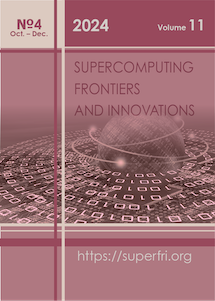Leveraging OpenMP Tasks for Efficient Parallel Modeling of the Elastic Eave Propagation in Multi-mesh Problems
DOI:
https://doi.org/10.14529/jsfi240407Keywords:
grid-characteristic method, OpenMP, task based parallelism, overset meshes, geological fracturesAbstract
This paper presents a new algorithm for parallelizing the grid-characteristic method in sharedmemory systems. The OpenMP task parallelism mechanism is used for parallelization. A modification of the grid-characteristic method is considered that uses a set of overlapped grids to determine a complex heterogeneous structure of the computational domain. The complexity of parallelizing the algorithm is represented by the presence of many different-sized grids. The proposed algorithm is described and compared with basic parallelization algorithms. Basic algorithms mean separate parallelization within each computational grid using the loop parallelization mechanism. An analysis of the efficiency of the post-doubling and parallel algorithms is performed. The advantage of the proposed algorithm for a number of problems is demonstrated. The results of testing and calculating the propagation of wave disturbances in a fractured layer are presented. Each crack in the example is specified by a separate computational grid, which significantly increases the multi-scale problem and the number of computational grids. Work is underway to transfer the algorithm to the three-dimensional case.
References
Intel VTune Profiler User Guide – intel.com. https://www.intel.com/content/www/us/en/develop/documentation/vtune-help/top.html, accessed: 2024-07-01
Appel¨o, D., Kreiss, G.: A new absorbing layer for elastic waves. Journal of Computational Physics 215, 642–660 (2006). https://doi.org/10.1016/J.JCP.2005.11.006
Benek, J., Buning, P., Steger, J.: A 3-D chimera grid embedding technique. American Institute of Aeronautics and Astronautics (1985). https://doi.org/10.2514/6.1985-1523
Benek, J.A., Steger, J.L., Dougherty, F.C., Buning, P.G.: Chimera. a grid-embedding technique (1986), https://apps.dtic.mil/sti/citations/ADA167466
Biryukov, V.A., Miryakha, V.A., Petrov, I.B., Khokhlov, N.I.: Simulation of elastic wave propagation in geological media: Intercomparison of three numerical methods. Computational Mathematics and Mathematical Physics 56(6), 1086–1095 (jun 2016). https://doi.org/10.1134/S0965542516060087
Board, O.A.R.: OpenMP Application Programming Interface Specification 5.2 (2021), https://www.openmp.org/specifications/, accessed: 2024-07-01
Chelnokov, F.B.: Explicit representation of grid-characteristic schemes for the elasticity equations in two- and three-dimensional space. Mathematical modeling 18, 96–108 (2006)
Favorskaya, A.V., Khokhlov, N.I., Petrov, I.B.: Grid-characteristic method on joint structured regular and curved grids for modeling coupled elastic and acoustic wave phenomena in objects of complex shape. Lobachevskii Journal of Mathematics 41, 512–525 (4 2020). https://doi.org/10.1134/S1995080220040083/FIGURES/16
Favorskaya, A.V., Zhdanov, M.S., Khokhlov, N.I., Petrov, I.B.: Modelling the wave phenomena in acoustic and elastic media with sharp variations of physical properties using the grid-characteristic method. Geophysical Prospecting 66, 1485–1502 (10 2018). https://doi.org/10.1111/1365-2478.12639
Furgailo, V., Ivanov, A., Khokhlov, N.: Research of Techniques to Improve the Performance of Explicit Numerical Methods on the CPU. In: 2019 Ivannikov Memorial Workshop (IVMEM). pp. 79–85. IEEE (sep 2019). https://doi.org/10.1109/IVMEM.2019.00019
Galis, M., Moczo, P., Kristek, J.: A 3-D hybrid finite-difference-finite-element viscoelastic modelling of seismic wave motion. Geophysical Journal International 175(1), 153–184 (oct 2008). https://doi.org/10.1111/j.1365-246X.2008.03866.x
Ivanov, A.M., Khokhlov, N.I.: Parallel implementation of the grid-characteristic method in the case of explicit contact boundaries. Computer Research and Modeling 10, 667–678 (2018). https://doi.org/10.20537/2076-7633-2018-10-5-667-678
K¨aser, M., Dumbser, M.: An arbitrary high-order discontinuous Galerkin method for elastic waves on unstructured meshes - I. The two-dimensional isotropic case with external source terms. Geophysical Journal International 166(2), 855–877 (aug 2006). https://doi.org/10.1111/j.1365-246X.2006.03051.x
Khokhlov, N., Petrov, I.: Application of the grid-characteristic method for solving the problems of the propagation of dynamic wave disturbances in high-performance computing systems. Proceedings of the Institute for System Programming of the RAS 31(6), 237–252 (2019). https://doi.org/10.15514/ISPRAS-2019-31(6)-16
Khokhlov, N.I., Favorskaya, A., Furgailo, V.: Grid-Characteristic Method on Overlapping Curvilinear Meshes for Modeling Elastic Waves Scattering on Geological Fractures. Minerals 12(12), 1597 (dec 2022). https://doi.org/10.3390/min12121597
Kozhemyachenko, A.A., Petrov, I.B., Favorskaya, A.V., Khokhlov, N.I.: Boundary Conditions for Modeling the Impact of Wheels on Railway Track. Computational Mathematics and Mathematical Physics 60(9), 1539–1554 (sep 2020). https://doi.org/10.1134/S0965542520090110
LeVeque, R.J.: Finite Volume Methods for Hyperbolic Problems. Cambridge University Press (8 2002). https://doi.org/10.1017/CBO9780511791253
Lisitsa, V., Tcheverda, V., Botter, C.: Combination of the discontinuous Galerkin method with finite differences for simulation of seismic wave propagation. Journal of Computational Physics 311, 142–157 (apr 2016). https://doi.org/10.1016/j.jcp.2016.02.005
Liu, W.K., Li, S., Park, H.S.: Eighty years of the finite element method: Birth, evolution, and future. Archives of Computational Methods in Engineering 29, 4431–4453 (6 2022). https://doi.org/10.1007/S11831-022-09740-9
Luo, S., Chen, Z.D.: A FDTD-based modal PML. IEEE Microwave and Wireless Components Letters 16, 528–530 (2006). https://doi.org/10.1109/LMWC.2006.882408
Magomedov, K., Kholodov, A.: The construction of difference schemes for hyperbolic equations based on characteristic relations. USSR Computational Mathematics and Mathematical Physics 9(2), 158–176 (1969). https://doi.org/https://doi.org/10.1016/0041-5553(69)90099-8
Mitskovets, I., Sagan, V., Khokhlov, N.: Parallel Modeling of Elastic Wave Propagation, with Explicit Pore Delineation Using Overset Grids Method. Physics of Particles and Nuclei 55(3), 516–518 (jun 2024). https://doi.org/10.1134/S1063779624030602
Mitskovets, I., Stetsyuk, V., Khokhlov, N.: Novel approach for modeling curved topography using overset grids and grid-characteristic method pp. 1–5 (1 2021). https://doi.org/10.3997/2214-4609.202011784
Novacki, W.: Theory of Elasticity. MIR (1975)
Vishnevsky, D., Lisitsa, V., Tcheverda, V.: Efficient Finite-difference Algorithm for Simulation of Seismic Waves in Models with Anisotropic Formations (apr 2012). https://doi.org/10.3997/2214-4609.20143647
Voigt, W.: Lehrbuch der kristallphysik (mit ausschluss der kristalloptik). B.G. Teubner (1910)
Yao, H.M., Jiang, L.: Machine-Learning-Based PML for the FDTD Method. IEEE Antennas and Wireless Propagation Letters 18, 192–196 (1 2019). https://doi.org/10.1109/LAWP.2018.2885570
Zienkiewicz, O.C., Taylor, R.L.R.L., Zhu, J.Z.: The finite element method: its basis and fundamentals. Elsevier, 7 edn. (2013)
Downloads
Published
How to Cite
Issue
License
Authors retain copyright and grant the journal right of first publication with the work simultaneously licensed under a Creative Commons Attribution-Non Commercial 3.0 License that allows others to share the work with an acknowledgement of the work's authorship and initial publication in this journal.

